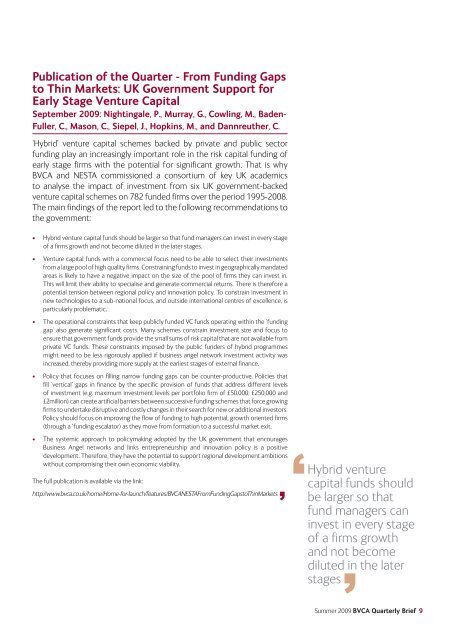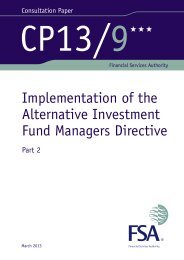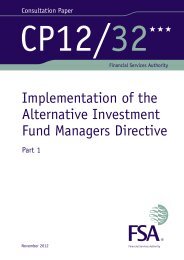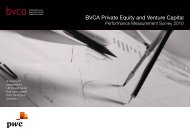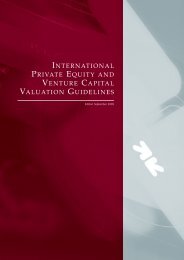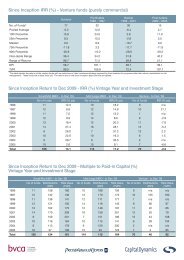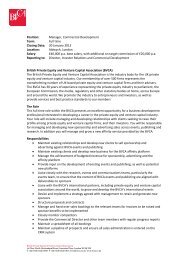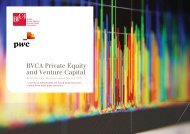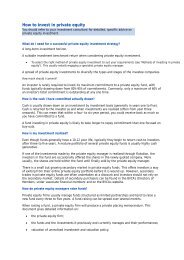What's inside - BVCA admin
What's inside - BVCA admin
What's inside - BVCA admin
You also want an ePaper? Increase the reach of your titles
YUMPU automatically turns print PDFs into web optimized ePapers that Google loves.
Publication of the Quarter - From Funding Gaps<br />
to Thin Markets: UK Government Support for<br />
Early Stage Venture Capital<br />
September 2009: Nightingale, P., Murray, G., Cowling, M., Baden-<br />
Fuller, C., Mason, C., Siepel, J., Hopkins, M., and Dannreuther, C.<br />
‘Hybrid’ venture capital schemes backed by private and public sector<br />
funding play an increasingly important role in the risk capital funding of<br />
early stage firms with the potential for significant growth. That is why<br />
<strong>BVCA</strong> and NESTA commissioned a consortium of key UK academics<br />
to analyse the impact of investment from six UK government-backed<br />
venture capital schemes on 782 funded firms over the period 1995-2008.<br />
The main findings of the report led to the following recommendations to<br />
the government:<br />
• Hybrid venture capital funds should be larger so that fund managers can invest in every stage<br />
of a firms growth and not become diluted in the later stages.<br />
• Venture capital funds with a commercial focus need to be able to select their investments<br />
from a large pool of high quality firms. Constraining funds to invest in geographically mandated<br />
areas is likely to have a negative impact on the size of the pool of firms they can invest in.<br />
This will limit their ability to specialise and generate commercial returns. There is therefore a<br />
potential tension between regional policy and innovation policy. To constrain investment in<br />
new technologies to a sub-national focus, and outside international centres of excellence, is<br />
particularly problematic.<br />
• The operational constraints that keep publicly funded VC funds operating within the ‘funding<br />
gap’ also generate significant costs. Many schemes constrain investment size and focus to<br />
ensure that government funds provide the small sums of risk capital that are not available from<br />
private VC funds. These constraints imposed by the public funders of hybrid programmes<br />
might need to be less rigorously applied if business angel network investment activity was<br />
increased, thereby providing more supply at the earliest stages of external finance.<br />
• Policy that focuses on filling narrow funding gaps can be counter-productive. Policies that<br />
fill ‘vertical’ gaps in finance by the specific provision of funds that address different levels<br />
of investment (e.g. maximum investment levels per portfolio firm of £50,000; £250,000 and<br />
£2million) can create artificial barriers between successive funding schemes that force growing<br />
firms to undertake disruptive and costly changes in their search for new or additional investors.<br />
Policy should focus on improving the flow of funding to high potential, growth oriented firms<br />
(through a ‘funding escalator) as they move from formation to a successful market exit.<br />
• The systemic approach to policymaking adopted by the UK government that encourages<br />
Business Angel networks and links entrepreneurship and innovation policy is a positive<br />
development. Therefore, they have the potential to support regional development ambitions<br />
without compromising their own economic viability.<br />
The full publication is available via the link:<br />
http://www.bvca.co.uk/home/Home-for-launch/features/<strong>BVCA</strong>NESTAFromFundingGapstoThinMarkets<br />
Hybrid venture<br />
capital funds should<br />
be larger so that<br />
fund managers can<br />
invest in every stage<br />
of a firms growth<br />
and not become<br />
diluted in the later<br />
stages<br />
Summer 2009 <strong>BVCA</strong> Quarterly Brief 9


